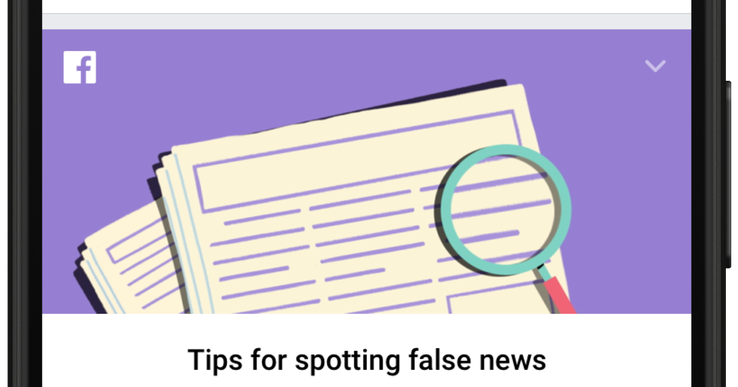

Today Facebook begins fighting misinformation with news literacy education, in addition to product features. This week, users in 14 countries, including the U.S., will see an alert above the News Feed several times over the next few days that links them to Facebook’s Help Center where they can read “Tips to Spot False News.” Written while working with news standards nonprofit First Draft, these tips include being skeptical of sensational headlines and checking for phony URLs.
Notably, Facebook is labeling the scourge “false news” instead of the more popular term “fake news.” The company tells me this is because “fake news” has taken on a life of its own, and “false news” more accurately communicates that it’s talking about intentionally false content that tries to be confused with legitimate news. After all, Donald Trump has begun labeling as “fake news” any opinions or facts with which he disagrees.
Facebook VP of News Feed Adam Mosseri writes “It’s not a new phenomenon, and all of us — tech companies, media companies, newsrooms, teachers — have a responsibility to do our part in addressing it.”
Unfortunately, Facebook could have made these tips much easier to consume and more likely to be read if it had just hosted them inside the News Feed alert itself. By instead linking out to the Help Center, the alert is likely to be repeatedly ignored by some, while others decline to wait for an outside site to load.

The alert at the top of the News Feed links out to the Facebook Help Center where users can read 10 tips for spotting false news
Here’s the list of tips users will find if they click through the link:
- Be skeptical of headlines. False news stories often have catchy headlines in all caps with exclamation points. If shocking claims in the headline sound unbelievable, they probably are.
- Look closely at the URL. A phony or look-alike URL may be a warning sign of false news. Many false news sites mimic authentic news sources by making small changes to the URL. You can go to the site and compare the URL to established sources.
- Investigate the source. Ensure that the story is written by a source that you trust with a reputation for accuracy. If the story comes from an unfamiliar organization, check their “About” section to learn more.
- Watch for unusual formatting. Many false news sites have misspellings or awkward layouts. Read carefully if you see these signs.
- Consider the photos. False news stories often contain manipulated images or videos. Sometimes the photo may be authentic, but taken out of context. You can search for the photo or image to verify where it came from.
- Inspect the dates. False news stories may contain timelines that make no sense, or event dates that have been altered.
- Check the evidence. Check the author’s sources to confirm that they are accurate. Lack of evidence or reliance on unnamed experts may indicate a false news story.
- Look at other reports. If no other news source is reporting the same story, it may indicate that the story is false. If the story is reported by multiple sources you trust, it’s more likely to be true.
- Is the story a joke? Sometimes false news stories can be hard to distinguish from humor or satire. Check whether the source is known for parody, and whether the story’s details and tone suggest it may be just for fun.
- Some stories are intentionally false. Think critically about the stories you read, and only share news that you know to be credible.
The tips are helpful and sensible, but the unfortunate fact is that they put a ton of faith in Facebook’s 1.8 billion users to exert lots of cognitive effort to detect false news.
Facebook came into this problem because of the poor news literacy, skepticism and proactive research behavior patterns of the modern news reader. According to studies, more than half of U.S. adults get their news from social media rather than directly from trusted sources, the majority of students can’t reliably distinguish fake news from real news and 20 percent of users on social media say that they’ve changed a social or political stance because of social media.

That’s why it’s also tried to take matters into its own hands with product changes and other projects, like working with outside fact checkers to label disputed news stories with warnings in the News Feed. It’s also provided a special option for flagging false news stories, down-ranked suspicious stories, began detecting and blocking false news spammers, denied false news publishers the ability to buy Facebook ads and funded the $14 million News Integrity Initiative.
But in the end it will fall to users to make up their own minds about what’s real and fake. And it’s tough to trust that any list of tips will suddenly make them strong fact checkers.

